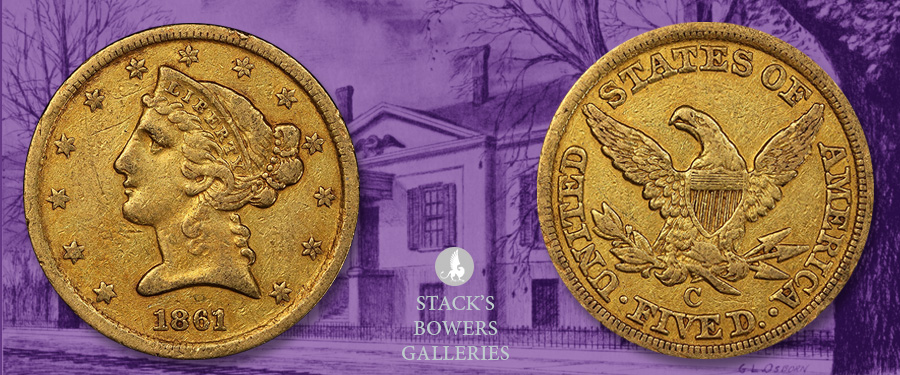
Coining operations did not immediately cease after the Confederate States of America seized the Charlotte Mint on April 20, 1861. Confederate troops occupied the building, turning it into a military headquarters and forcing employees to swear loyalty to the Confederacy or lose their jobs. The building hosted federal troops for a period during Reconstruction, and the facility later functioned as an Assay Office.
Experts think that 887 gold half eagles were struck in late May 1861 after the mint was seized. Unfortunately for collectors, these are indistinguishable from those struck under federal auspices. In our Spring 2023 Whitman Expo Auction, Stack’s Bowers Galleries will offer an example of this historic date, pedigreed to the CAG Set of the Fairmont Collection.
The small mintage for the 1861-C half eagle, paired with significant collector demand for the historic date, makes it a desirable issue indeed. Roughly 200 examples are thought to exist, an estimate roughly borne out by the certified populations from both major third-party grading services.
Enhancing its desirability, the strike quality of 1861-C half eagles was superior in 1861 than it had been in either of the preceding two years, according to David Akers. Doug Winter concurs, writing in his book on Charlotte Mint gold coinage, “The 1861-C is much better struck than either the 1859-C or the 1860-C half eagles. The obverse is fairly sharp with the exception of some weakness on the curls around the face. The curl below the ear is always weak. The top of the head is strong, as are the details on the bun. The first star is usually very flat while the rest are sharper with many showing full or nearly full radial lines. The border is sometimes weak from 3:00 to 6:00 with die crumbling noted on the denticles. I have seen some examples, however, with fully defined obverse denticles. The reverse is better struck than the obverse. Some have weakness seen on the neck of the eagle, but the overall level of sharpness is unmatched by any other of the late half eagles from this mint and is comparable to that seen on some of the issues from early 1850s.”
Winter also points out that the coins entered circulation directly from the mint and circulated widely, which might explain the relatively large populations of lightly and moderately circulated examples in third-party grading services’ censuses. Original color is very scarce and impaired luster is the norm for the date. Eye appeal is, according to Winter, stronger for pieces in the Extremely Fine grade range than About Uncirculated examples.
The 1861-C half eagle featured in our Spring auction is graded VF-35 by PCGS with CAC approval. Its assigned grade places it solidly in the middle of those on PCGS’ Population Report, which reports seven other grading events for the date in VF-35. Interestingly, coins in VF-35 don’t cross the block very often; the last such sale recorded on PCGS CoinFacts was in our (Bowers and Merena) January 1994 sale, when we sold an example certified by PCGS for $2,200.
The coin’s die state suggests that it was struck before the Confederacy seized the mint, though proof remains elusive.
For more information: https://www.numismaticnews.net/archive/coins-of-1861-controlled-by-the-south
Preview the Fairmont Collection – CAG Set.





